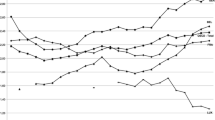Abstract
The State of São Paulo plays an important role in national research activities. The Foundation for the Support of Research of São Paulo State (FAPESP) is commissioned to manage funds for these activities. The profile of Brazilian sciences is investigated and contrasted to FAPESP's investments.
ISI date relative to years 1981 to 1995 are analysed through multivariate methods (Factor and Cluster Analysis) as to provide weighted ranks of research fields, relationships among them as geometric distances, and group classification. This information is compared to public reports on FAPESP's expenditures.
Brazilian scientific production grows at 244 papers/year in the period, and its global share is almost doubled. Impact shows no trend. Best performers are from exact and biological sciences. Though impact varies greatly among research fields, their major distinctive feature is magnitude of production. The six top research fields identified (Physics, Biology & Biochemistry, Clinical Medicine, Engineering, Chemistry, Plant & Animal Sciences) were found to equally be the prime beneficiaries FAPESP's investments.
The Brazilian scenario is one of increasing production under an international pattern. This trend is not accompanied by changes in impact. As a corollary, volume of publications rises as an important issue. Public investments from São Paulo State adequately conform this scenario giving reassurance that resouces are not being squandered.
Similar content being viewed by others
References
Altbach, P. G., Lewis, L. S. (1996), The academic profession in international perspective. In:Altbach, P. G. (Ed.),The international academic profession. Portraits of fourteen countries. Princeton: The Carnegie Foundation for the Advancement of Teaching, pp 25–26.
Holm-Nielsen, L., Crawford, M., Saliba, A. (Ed.) 1995,Institutional and Entrepreneurial Leadership in the Brazilian Science and Technology Sector. World Bank Discussion Papers.
Sbragia, R., Kruglianskas, I. (1996), R&D in Brazilian industry: Recent indicators.Research Technology Management, (May–June) 30–35.
Leta, J., Lannes, D., De Meis, L. (1998), Human resources and scientific productivity in Brazil,Scientometrics, 41(3), 313–324.
Guimaraes, J. A., Humann, M. C. (1995), Training of human resources in science and technology in Brazil-The importance of a vigorous postgraduate program and its impact on the development of the country,Scientometrics, 34(1), 101–119.
Narin, F., Hamilton, K. S., Olivastro, D. (1997), The increasing linkage between US technology and public science,Research Policy, 26(3), 317–330.
Schwartzman, S. (1992), The support to research in Brazil,Interciencia, 17(6), 329–333.
Marshall, E. (1995), Brazil-Agency is refuge in funding wilderness,Science, 267(5199), 812–813.
Schwartzman, S., Balbachevsky, E. (1996), The academic profession in Brazil. In:Altbach P. G. (Ed.),The international academic profession. Portraits of fourteen countries. Princeton: The Carnegie Foundation for the Advancement of Teaching, pp 231–279.
Pereira, J. C. R., Pires, M. L., Duarte, P. S., Paes, A. T., Okano, V. (1966), Introducing a method of research evaluation into a university: medical research at the University of São Paulo, Brazil,Research Evaluation, 6(1), 37–42.
Hair, J. F. Jr,Anderson, R. E., Tatham, R. L. (1987),Multivariate Data Analysis, New York, Macmillan Publishing Co., pp 233–260.
Jackson, B. B. (1983),Multivariate Data Analysis, Homewood (Illinois), Richard D. Irwin Inc., pp 153–189.
Luukkonen-Gronow, T. (1987), Scientific research evaluation: A review of methods and various contexts of their application,R&D Management, 17(3), 207–221.
Thomas, P. R., Watkins, D. S. (1998), Institutional research rankings via bibliometric analysis and direct peer review: A comparative case study with policy implications,Scientometrics, 41(3), 335–355.
So, C. Y. K. (1998), Citation ranking versus expert judgement in evaluating communication scholars: Effects of research speciality size and individual prominence,Scientometrics, 41(3), 325–333.
De Meis, L., Machado, R. C. P., Fonseca, L., Lustosa, P., Caldeira, M. T. (1992), Cienciametria y evaluactiones por los proprios investigadores,Interciencia, 17(1), 40–43.
Leta, J., De Meis, L. (1996), A profile of science in Brazil,Scientometrics, 35(1), 33–44.
Author information
Authors and Affiliations
Rights and permissions
About this article
Cite this article
Pereira, J.C.R., Escuder, M.M.L. & Zanetta, D.M.T. Brazilian sciences and government funding at the State of São Paulo. Scientometrics 43, 177–188 (1998). https://doi.org/10.1007/BF02458406
Received:
Issue Date:
DOI: https://doi.org/10.1007/BF02458406




